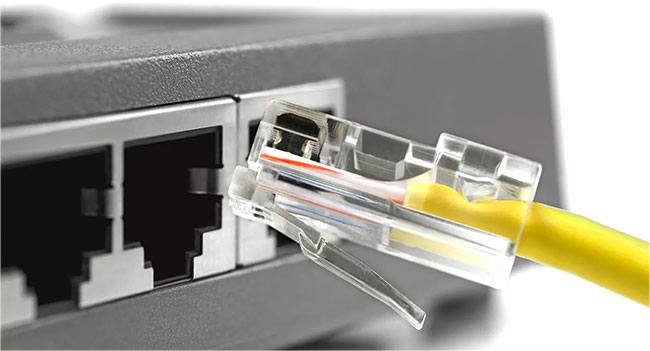What is the Uplink port on a computer network?
Uplink in computer networks refers to wired or wireless connection from local area network (LAN) to wide area network (WAN). The uplink port on a home router is a special port used to connect to a broadband modem (the LAN itself), and finally the Internet (or LAN).
In telecommunications, an uplink is a wireless connection made from the ground to a communications satellite orbiting the Earth.
Uplink and downlink
Downlink is a connection made in the opposite direction to the uplink, from the satellite to the ground or from the external network to the local network. For example, downloads from the Internet move over a downlink to a download device, while uploads to the Internet move over an uplink connection.
 Downlink is a connection made in the opposite direction of uplink
Downlink is a connection made in the opposite direction of uplink Uplink is often used in satellite telecommunication to broadcast radio and television. The signal is transmitted from the ground station to the orbiting satellite and this process is called satellite uplink.
Other wireless and mobile broadband providers sometimes treat an upstream communication line as an uplink transmission. These links may carry text messages, file uploads to the Internet and other data sent through the provider's network.
Uplink port on the computer network
Some computer network hardware has uplink ports designed to plug network cables. These ports allow one network to communicate with other external networks. For example, uplink ports on home routers allow connection to broadband modems and the Internet.
Ethernet hubs, switches and routers have traditionally designated an Ethernet port as an uplink connection, which is marked on the device by a unique name or color. Home broadband routers often label this port as WAN or Internet instead of uplink , but the concept and functionality remain the same.
 Uplink port on the computer network
Uplink port on the computer network Uplink connections can be used to:
- Connect a broadband modem to a home router to access the Internet.
- Connect an uplink device (router, switch or hub) to another device. For example, plug one uplink port into the standard port of another switch to expand the network size.
In contrast, uplink connections are usually not used to:
- Connect two uplink ports together.
- Connect the computer to the uplink port.
In modern computer networks, connections are bidirectional. For connections to the uplink port, the same cable or wireless link can transfer data from and to devices at either end instead of just "up" or "down". The terms uplink and downlink here apply to the connector side that starts transferring data.
Network experts point out that Ethernet crossover cables can be used to connect computers to uplink ports or to connect two uplink ports. While technically, the usefulness of this type of connection is limited.
Multipurpose uplink port and share
The traditional hardware logic of an uplink port is that it only supports network uplink devices. However, many modern broadband routers at home offer an alternative multipurpose port, both acting as an uplink and as a standard port, depending on the type of device connected to it.
Before universal ports became popular, some older network devices configured a standard port next to the uplink port and linked the two ports together into a pair. The hardware logic of these products is to support connections to standard uplink or shared ports, but cannot support both. Connecting to both ports of a device with a shared port will prevent the device from working properly.
You should read it
- Is the WAN port of the router connected to the computer?
- How to connect printer 2.0 USB port to USB 3.0 port on Windows 10
- Summary of some simple ways to disable USB ports on Windows computers
- What is AAA PC Port? Why do they have so many problems?
- How to change LPT port in CMOS
- 6 simple steps to install Port Forwarding on the Router
 What is TeamViewer?
What is TeamViewer? What is FTP? Things you didn't know about FTP
What is FTP? Things you didn't know about FTP How to control a remote computer with AnyDesk Remote
How to control a remote computer with AnyDesk Remote How to set up wireless home network with mobile phones
How to set up wireless home network with mobile phones How to scan local area network with Terminal on macOS
How to scan local area network with Terminal on macOS How to change Ultraviewer access password
How to change Ultraviewer access password